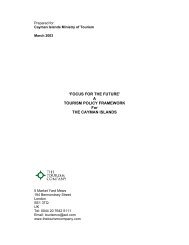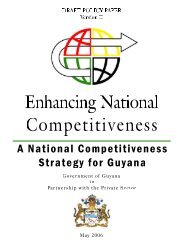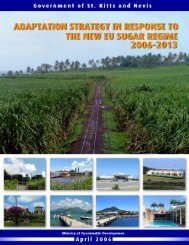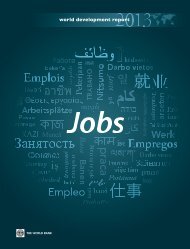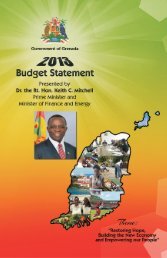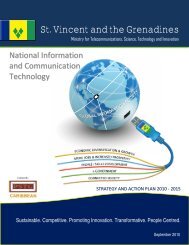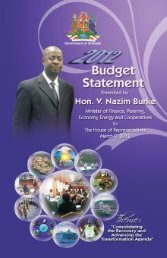Business Removing
Doing Business in 2005 -- Removing Obstacles to Growth
Doing Business in 2005 -- Removing Obstacles to Growth
- No tags were found...
Create successful ePaper yourself
Turn your PDF publications into a flip-book with our unique Google optimized e-Paper software.
PROTECTING INVESTORS 53<br />
FIGURE 7.4<br />
Pyramid structures can mask related-party transactions<br />
Controlling<br />
family<br />
1b<br />
51%<br />
51%<br />
Choten<br />
2b<br />
Public<br />
investors<br />
Ichi<br />
Ni<br />
1b<br />
1b<br />
51% 51% 51%<br />
51%<br />
Futatsu-Ichi Futatsu-Ni Futatsu-San Futatsu-Yon<br />
1b 1b 1b 1b<br />
Source: Aikawa (1934).<br />
51%<br />
Total public<br />
investment<br />
4b<br />
takes Choten public and raises almost an additional ¥1<br />
billion. It then organizes 2 other businesses, Ichi and Ni,<br />
each financed with ¥500 million from Choten and almost<br />
¥500 million in public equity. Another 4 firms are<br />
organized under Ichi and Ni with the same strategy (figure<br />
7.4). Now the family fully controls 7 firms, with ¥5<br />
billion in consolidated assets, by leveraging ¥4 billion<br />
from small investors. To raise the same equity through<br />
Choten alone, their ownership would have been diluted<br />
to a minority 20%. Good for the family. But minority investors<br />
are more vulnerable to expropriation if they are<br />
unaware of how business between Choten and its subsidiaries<br />
could benefit the controlling family.<br />
Beneficial ownership. A third way to gain control is<br />
through nominee accounts, trust funds, or brokerage<br />
firms, where the identity of the buyer is not disclosed. 18<br />
This practice is so popular in Indonesia, that by 1996<br />
the Suharto family managed to amass control of 417<br />
companies, 21 of them publicly-listed, using nominee<br />
accounts and trusts. The practice is still permitted. In<br />
contrast, Malaysia revised its regulation in 2001 to limit<br />
nominee ownership.<br />
Voting agreements. Fourth, shareholders may have<br />
agreements that stipulate collective voting on strategic<br />
issues or managerial appointments. If these agreements<br />
are not disclosed, as in Jordan, the Philippines or Turkey,<br />
small investors may lose out.<br />
In addition to ownership disclosure, 2 types of financial<br />
disclosure help investors.<br />
Audit committees. The quality of financial information<br />
is increased if the company law or securities law<br />
requires internal audits before financial statements are<br />
released to investors. The business can have an audit<br />
committee that reviews and certifies financial data. Better<br />
yet, the committee may include some outside members.<br />
Korea has made the most progress, by mandating<br />
audit committees and also requiring that two-thirds of<br />
the committee members in large companies be outsiders.<br />
External audits. Laws can also require that an external<br />
auditor be appointed. Countries like Argentina and<br />
Spain have both an internal audit committee and an external<br />
auditor, while Hungary, like many other countries,<br />
has a requirement only for an external auditor. One<br />
caveat: in many countries external auditors are not so independent.<br />
In Peru, for example, an estimated 6,000 auditors<br />
vie for the business of 200 listed companies, which<br />
pay the highest fees for auditing services. Sometimes, the<br />
most malleable auditors get the job.<br />
Public access to information. Finally, disclosure is<br />
most effective when both ownership and financial information<br />
are available to all current and potential investors,<br />
either in stock exchange bulletins if the company<br />
is public, or in annual reports, newspapers, or company<br />
registries for privately held companies. One example. In<br />
2000 the Australian Stock Exchange introduced a realtime<br />
disclosure system that utilizes the Internet for reporting<br />
information that may affect investors’ choices. It<br />
also monitors the media for company announcements<br />
that may have not been reported but fall under the disclosure<br />
regulation. About 300 such announcements were<br />
detected last year. Yet in countries like Saudi Arabia or<br />
Venezuela, only the regulators have access to ownership<br />
information.<br />
The 7 ways of enhancing disclosure—by reporting<br />
family, indirect, and beneficial ownership, and on voting<br />
agreements between shareholders, by requiring audit<br />
committees of the board of directors and the use of<br />
external auditors, and by making such information<br />
available to all current and potential investors—make up<br />
the Doing <strong>Business</strong> indicator of disclosure (table 7.3).<br />
Twenty four countries have 6 or more of these features.<br />
Thirty others—almost all poor countries—have fewer<br />
than two.<br />
Legal protections<br />
Disclosure of ownership and financial information is<br />
just the beginning. Legal protections of the rights of<br />
small investors are needed. In the Peronnet case, for example,<br />
failure to disclose was not sufficient to void the<br />
lease agreement with SCI. The court ruled that the decision<br />
to lease was not taken with the sole intention of<br />
benefiting the majority shareholder and served a legitimate<br />
business purpose. It took no interest in the question<br />
of whether the creation of SCI and the price it



